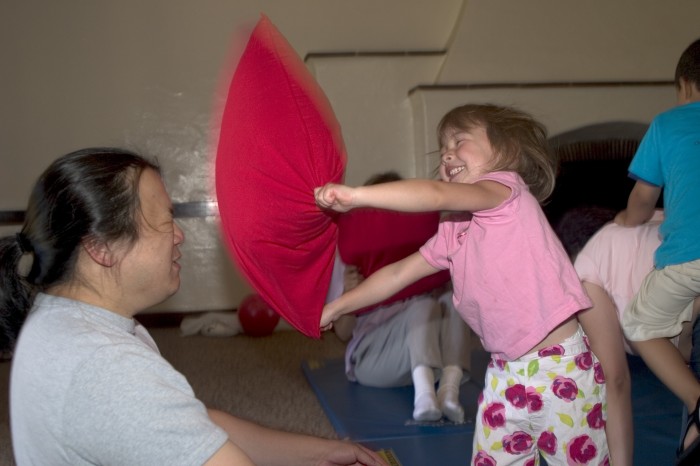 If we wanted to make a list of things that irritate parents, we'd find children whining near the top! It's a behavior that every child tries sooner or later. Some children fall into whining and can’t seem to climb back out. By the time a parent decides to search for advice about handling whining, he is usually fed up.
If we wanted to make a list of things that irritate parents, we'd find children whining near the top! It's a behavior that every child tries sooner or later. Some children fall into whining and can’t seem to climb back out. By the time a parent decides to search for advice about handling whining, he is usually fed up.
When a child is whining, filling his request probably won't change his emotional climate for long. When children whine, the inner weather is cloudy, with a storm on the horizon. Filling his request might gain a parent a few moments of peace, but the child’s overall mood sinks back into a tone of “I am unhappy” soon again.
Sending a child off to his room or punishing him for whining won’t improve the situation either. He might come back from punishment or time out a quieter person, but he won’t feel good inside. He will probably find ways to balk, to stir up difficulties with others, or to zone out. This persistent unhappiness is hard on parents. When we take the time and energy to try to solve a problem, we parents feel insulted when it doesn’t stay solved!
Whining children are communicating important information
 We'd like to offer you a fresh way to understand why your child whines, and give you some interesting solutions to try. We start with the observation that, like every other behavior children have, whining is important communication. We parents wish the message would come in some other form—any other form! But whining is news from your child, hot off the press. The headline is: “I feel alone! I feel powerless!”
We'd like to offer you a fresh way to understand why your child whines, and give you some interesting solutions to try. We start with the observation that, like every other behavior children have, whining is important communication. We parents wish the message would come in some other form—any other form! But whining is news from your child, hot off the press. The headline is: “I feel alone! I feel powerless!”
Usually, whining happens shortly after a child’s sense of connection to their parent or caregiver has broken. The ordinary things parents must do, like feeding little brother, cooking dinner, or talking to a friend on the phone, can eat away at a child's sense that he's connected and cared about. For small children in a big world, feeling disconnected gnaws at their spirits. They flash a signal for help: “I wannaaaa cooookkkiiieee!” It comes with a miserable expression and a body that can barely move.
Once children feel disconnected, any small task can bring up jumbo-size feelings of powerlessness. Having to get dressed when they want to stay in their pajamas, having to brush their teeth when they'd rather play with the cat, and having to say goodbye and go to school or day care can bring on whining.
Whining children have real needs
A whining child probably won’t be satisfied by the attempt you make to help, but he does have a real need. He needs you. Not just the things you do. He needs to feel connected to you. Only a sense of connection can mend that awful out-of-sorts feeling that's bothering him.
Children are built to feel close to the people they're with—close to their parents, their caregivers, their grandparents and cousins and friends. When they can feel close and cherished, they behave with confidence. When they don't feel close to anyone, their behavior goes haywire immediately.
Whining children have feelings that won’t be rational

Comings and goings, moving from one activity to another, seeing you busy or preoccupied with other things, or having several siblings who compete for your attention all eat away at child's sense that all is sweet between you and him. Sometimes even when parents are available, full of warm attention at the moment, children can feel disconnected; children can't feel their love or caring because the feeling, “I’m alone,” has already taken over. Human feelings often paint an emotional picture that’s far from the reality of the situation.
For instance, whining often happens toward the end of a sweet, close playtime during which you've done the things your child loves to do. You've done your utmost to make things good, but suddenly, you have a dissatisfied child, who moans, “You never do anything I want!” It's enough to make a parent feel: “I'm never taking you to the park again if this is the way you behave!”
This happens because, at the prospect of the end of the good time, feelings of helplessness or loneliness stored up from earlier experience crop up and take over. The feelings may come from yesterday or from as far afield as infancy—they lurk in the child’s mind, and are brought into play by simple, everyday moments.
Whining children aren't trying to manipulate you
When your child is whining, he isn't out to get you. He doesn't really want you to give in to irrational requests. He’s trying to signal that he needs your help.
He has chosen something irrational to want, so that you will say a gentle, firm “No.” Then he can open up bad feelings. While he is crying, he will actually shed these feelings. If you listen, he will eventually notice your presence, notice your love, and feel much better about himself and his world. He’ll stop needing what he was crying for, because he has you.
Try to picture him saying, “I wannnaaa cookkkiiee,” but meaning, “Please say ‘No.’ I need a good cry with your arms around me!”
Help your child connect again
Whining indicates that your child needs an emotional outlet before he'll be able to regain his sense that you are on his side. Laughter, crying, and tantrums are typical ways children release bad feelings.
A good laugh (but don’t force laughter by tickling), a good cry (without upset or punishment from you), or a good tantrum (without hurrying the child to finish) will cure that gnawing sense of helplessness or loneliness that causes whining.
Once your child regains a sense of connection with you or any other member of the family, he'll be able to take charge again. He'll ask for what he wants, without the “poor me” tone. He’ll be easier to live with. So your energy will be well spent if you focus on rebuilding a connection with your child.
Try filling your child’s request once
A whining child does indeed need your attention for at least a moment or two.
At first, you won’t really know whether getting the thing he asks for will help him feel connected and capable again, or not. His request may seem reasonable to you—a drink of water, help with his shoes, one more turn listening to his favorite music. If giving him the thing he wants makes sense to you, go ahead and try it once. But if more whining follows, you can be sure that the real problem is his emotional “weather.” A storm is coming.
If he’s not satisfied, offer closeness and a clear limit
The cold tone that most of us use when we say, “No,” serves to make a child feel even more alone and adrift in an uncaring world. It deepens the rut your child is whining in.
If you can say, “Nope, no more cookies! Maybe tomorrow!” with a big grin and a kiss on the cheek, your child receives contact from you in place of cookies. If he whines some more, you can come back and say, “Nah, nah, nah, nah!” and nuzzle into his neck, ending with a little kiss. If he persists, bring him still more affection, “I'm your chocolate chip cookie! I’m all yours!” with a big grin. Then throw your arms around him and scoop him up. At some point, the affection you're offering will tip him toward either laughter or a tantrum.
Both results, as odd as it may seem, are great for him. Laughter, tears, and tantrums help dissolve that shell of separateness that can enclose a child, as long as you listen and care. After a good cry (you listen, and keep sweetly saying, “No, James, no more cookies,” until he’s finished crying), or a good tantrum (“Yes, you really want one, I know, son”), or a good laugh (“I’m coming to give you big cookie kisses!”), he will feel your love for him again.
If you can't be playful, be attentive
Playful moments don't come easily to us when our children whine. So if you can't find a way to nuzzle your child or respond with humor to his whiny requests, it will work well to come close and keep saying, with as little irritation as you can manage, “No,” “You need to wait,” “I can't let you do that,” “He's playing with it now,” or “You'll get a turn, but not yet.”
Being very clear about the limit, and offering eye contact, a hand on his shoulder or knee, and whatever warmth you can muster, will help your child work himself into the cry or the tantrum or laughter he needs to do. Children know how to release feelings of upset. To get started, they just need us to pay attention to them long enough to communicate that we'll stay with them through this rough patch.
Allow for laughter, tantrums, or tears for as long as you have time and patience

Children whine when lots of feelings have backed up inside them. When they finally break into a good wail or thrash, they may be working through more than the frustration of not getting the cookie or the red truck. They may be draining the tension from issues like having a younger brother or sister, having to say goodbye to you every morning, or having just gotten over an illness. In any case, children need to shed bad feelings until they don't feel bad any longer.
If the pile of feelings is high, this can take some time. Parents don't always have the time a child needs to finish the emotional task at hand. You may manage to listen to fifteen or twenty minutes of crying, and then feel the need to stop your child. If your child’s mood doesn’t improve, he wasn’t finished. It’s as hard for a child to have an unfinished cry as it is to be awakened in the middle of a nap. He’ll try to find a way to cry again soon. Something inside him knows that it will be good to finish the job. So listen again when you can. Your child will eventually finish his emotional episode, and make gains in confidence that both of you can enjoy.
Listening time can help you keep perspective when whining begins
The hard part about trying the experiments above is that whining triggers all kinds of irrational feelings inside of us. Whining kicks up feelings of resentment, exhaustion, and anger in parents.
We feel like we’re being manipulated. We feel helpless.
When our feelings surge, we don't think logically either. We react, usually behaving the way our parents reacted to our whining. The reactions we have to whining have been passed down through the generations in our families, each generation usually doing a milder version than the generation before it.
So it takes some mental preparation to decide to move toward a whining child and offer connection, rather than placate him or punish him.
Every parent deserves someone to listen to how hard it can be to care for a child or children. So finding ways to be heard by another adult who won't get worried or try to “fix” us is an important part of our job as parents. The Hand in Hand booklet Listening Partnerships for Parents outlines how you can create a listening exchange for yourself, so you have a regular outlet for the feelings that build up over the days and weeks with your child (check out our Parent Club Community for support in finding a Listening Partner).
Even ten minutes of “venting” with a friend, out of earshot of your child, will give you a better chance of moving toward your whining child and connecting.
Here’s how it can work:
I was playing with a mother and her nearly four-year-old boy, Joey, in the sandbox. A good friend of his, Sam, was also playing there, several feet away. Joey had played with a plastic construction helmet, and had put it down. He was busy with a tractor when Sam picked up the helmet and put it on.
Joey whined, “I want the hat! He took my hat!” He sat and looked at his mom, miserable. She got worried and said, “Do you want to go and talk to Sam about the hat?” and he whined, “I want you to go and talk to him. You do it.” I invited the Mom to slow down the action, and indicated that she didn’t need to fix the situation. He was clearly unhappy, and mad, too. A helmet wasn't going to fix the feelings he was carrying.
She did slow things down. She said, “OK, Joey, we can go and talk to him in a few minutes, but not now.” He was able to begin to cry. She didn't try to pick him up or comfort him—he wasn't going to let her get that close. But she did stay right there. She looked at him, and listened as he showed his feelings. He cried, kept saying he wanted the helmet, and then proceeded to dig his feet into the sand again and again, not kicking sand, but pushing piles of it away from him and toward his Mom. She listened. He cried and pushed at the sand for several more moments, and then he was finished. His face relaxed. He asked her to help him with some other project in the sand. He felt satisfied, and together, they continued playing. He didn't need the helmet any longer. And his requests from then on were direct and confident.

